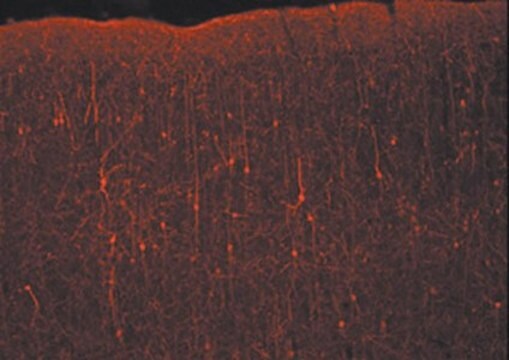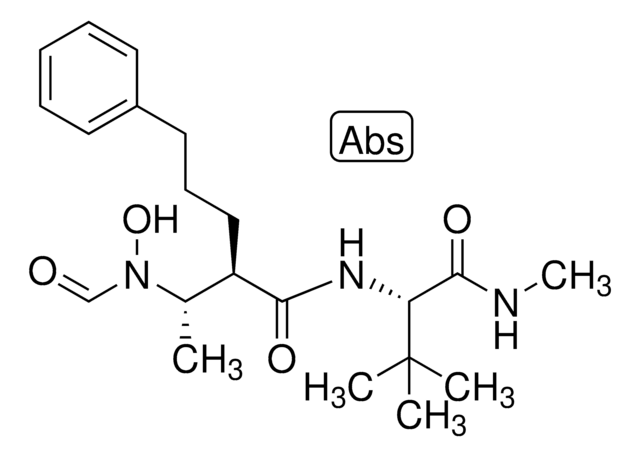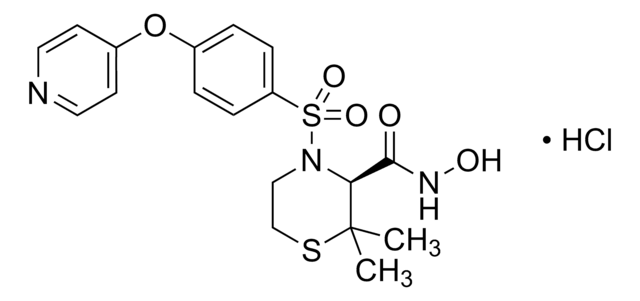CC1100
GM6001 MMP Inhibitor Powder
The GM6001 MMP Inhibitor Powder controls the biological activity of MMP. This small molecule/inhibitor is primarily used for Biochemicals applications.
Sinônimo(s):
GM6001 Inhibitor
Faça loginpara ver os preços organizacionais e de contrato
About This Item
Código UNSPSC:
12352200
eCl@ss:
32160405
NACRES:
NA.77
Produtos recomendados
Descrição geral
specificity:GM6001 MMP inhibitor, also known as Ilomastat or N-[(2R)-2-(hydroxamidocarbonylmethyl)-4-methylpentanoyl]-L-tryptophan methylamide, is a potent inhibitor of collagenases. Molecular weight: 388.47
Reported Ki values are as follows (see Galardy Ref):
Human MMP-1 (Fibroblast collagenase): 0.4 nM
Human MMP-3 (Stromelysin): 27 nM
Human MMP-2 (72 kDa gelatinase): 0.5 nM
Human MMP-8 (Neutrophil collagenase): 0.1 nM
Human MMP-9 (92 kDa gelatinase): 0.2 nM
Typical working dilution for use in cultured cells is 10-25 μM. {1mg/ml solution in DMSO equals 2.57 mM}. GM6001 will precipitate from aqueous solutions exceeding 100μM. Aqueous dilutions should be performed using low salt buffers to prevent precipitation of GM6001 from solution (Recommended dilution buffer: 50 mM Tris pH7.5, 150 mM NaCl, and 20 mM CaCl2.2H20). It is recommended that the concentration of GM6001 in aqueous working solutions is determined upon dilution and confirmed prior to each use. Additional Application information:
Use in vivo
Typical dosage for GM6001 in animals is 50-100mg/kg body weight. It is generally administered IP every day or every other day. It is thought to cross the blood brain barrier since studies have shown it effectiveness in MS models.
If delivered by I.V. the half life in an animal is approximate an hour so it will have to be administered quite often. Thus the preferred way is to deliver the drug by I.P as a suspension in water or saline. The half life does not change but because it is dissolving in the animal′s system slowly, administration is not done as frequently. It has to be redelivered every other day or so. It can also be delivered subcutaneously in a saline suspension. The drug will precipitate as stay as a mass within the tissue, but surprisingly enough does get into the animal system to be effective.
Solubility
Soluble up to at least 400 mg/mL in DMSO. It can then be diluted in water and must be mixed very quickly to avoid precipitation.
Stability
At a concentration of 1mM (0.1mM is preferred), GM6001 decomposes at the rate of 1% per month at 4°C. At 37°C this increases to 1% per day. At -20°C it is quite stable, and as a solid very highly stable
Low salt buffers are recommended as diluents to reduce precipitation. Diluted solutions should never be frozen.
Concentration of the stock solution should be periodically determined by absorbance at 280 nm.
Reported Ki values are as follows (see Galardy Ref):
Human MMP-1 (Fibroblast collagenase): 0.4 nM
Human MMP-3 (Stromelysin): 27 nM
Human MMP-2 (72 kDa gelatinase): 0.5 nM
Human MMP-8 (Neutrophil collagenase): 0.1 nM
Human MMP-9 (92 kDa gelatinase): 0.2 nM
Typical working dilution for use in cultured cells is 10-25 μM. {1mg/ml solution in DMSO equals 2.57 mM}. GM6001 will precipitate from aqueous solutions exceeding 100μM. Aqueous dilutions should be performed using low salt buffers to prevent precipitation of GM6001 from solution (Recommended dilution buffer: 50 mM Tris pH7.5, 150 mM NaCl, and 20 mM CaCl2.2H20). It is recommended that the concentration of GM6001 in aqueous working solutions is determined upon dilution and confirmed prior to each use. Additional Application information:
Use in vivo
Typical dosage for GM6001 in animals is 50-100mg/kg body weight. It is generally administered IP every day or every other day. It is thought to cross the blood brain barrier since studies have shown it effectiveness in MS models.
If delivered by I.V. the half life in an animal is approximate an hour so it will have to be administered quite often. Thus the preferred way is to deliver the drug by I.P as a suspension in water or saline. The half life does not change but because it is dissolving in the animal′s system slowly, administration is not done as frequently. It has to be redelivered every other day or so. It can also be delivered subcutaneously in a saline suspension. The drug will precipitate as stay as a mass within the tissue, but surprisingly enough does get into the animal system to be effective.
Solubility
Soluble up to at least 400 mg/mL in DMSO. It can then be diluted in water and must be mixed very quickly to avoid precipitation.
Stability
At a concentration of 1mM (0.1mM is preferred), GM6001 decomposes at the rate of 1% per month at 4°C. At 37°C this increases to 1% per day. At -20°C it is quite stable, and as a solid very highly stable
Low salt buffers are recommended as diluents to reduce precipitation. Diluted solutions should never be frozen.
Concentration of the stock solution should be periodically determined by absorbance at 280 nm.
Aplicação
The GM6001 MMP Inhibitor Powder controls the biological activity of MMP. This small molecule/inhibitor is primarily used for Biochemicals applications.
Ações bioquímicas/fisiológicas
Inhibitor Type: Protease Inhibitors
Protein Target: Interstitial collagenase
forma física
Lyophilized, reconstitute in DMSO (1-5 mg/ml). Other organic solvents (ethanol) have also been used (Galardy et al., 1994).
some batches can be brown when hydrated; brown color does not influence inhibition ability; in solution GM6001 ranges from clear to brown
Armazenamento e estabilidade
Maintain lyophilized form at 2-8º C for up to one year from date of receipt. If reconstitution is in DMSO, material is soluble to at least 400 mg/mL and storage is recommended in usable aliquots at -20 º C. Avoid repeated freeze/thaw cycles. If reconstituting in aqueous solution, store short term in undiluted aliquots at 2-8º C. See stability information for further detail.
Informações legais
CHEMICON is a registered trademark of Merck KGaA, Darmstadt, Germany
Exoneração de responsabilidade
Unless otherwise stated in our catalog or other company documentation accompanying the product(s), our products are intended for research use only and are not to be used for any other purpose, which includes but is not limited to, unauthorized commercial uses, in vitro diagnostic uses, ex vivo or in vivo therapeutic uses or any type of consumption or application to humans or animals.
Código de classe de armazenamento
11 - Combustible Solids
Classe de risco de água (WGK)
WGK 3
Ponto de fulgor (°F)
Not applicable
Ponto de fulgor (°C)
Not applicable
Certificados de análise (COA)
Busque Certificados de análise (COA) digitando o Número do Lote do produto. Os números de lote e remessa podem ser encontrados no rótulo de um produto após a palavra “Lot” ou “Batch”.
Já possui este produto?
Encontre a documentação dos produtos que você adquiriu recentemente na biblioteca de documentos.
Joseph F Porter et al.
Breast cancer research and treatment, 94(2), 185-193 (2005-09-06)
Tissue inhibitor of metalloproteinases-1 (TIMP-1) is a widely expressed, secreted protein that functions primarily to inhibit members of a large family of metalloproteinases (MPs). Because of the ability of TIMP-1 to inhibit MPs, it functions in many of the same
D E Levy et al.
Journal of medicinal chemistry, 41(2), 199-223 (1998-02-11)
Modifications around the dipeptide-mimetic core of a hydroxamic acid based matrix metalloproteinase inhibitor were studied. These variations incorporated a variety of natural, unnatural, and synthetic amino acids in addition to modifications of the P1' and P3' substituents. The results of
Sean E Gill et al.
Developmental biology, 261(2), 313-323 (2003-09-23)
Tissue inhibitors of metalloproteinases (TIMPs) regulate extracellular matrix (ECM) degradation by matrix metalloproteinases (MMPs). We have examined the role of TIMP-3 on ECM homeostasis and bronchiole branching morphogenesis during murine embryogenesis. Employing an in vitro organ culture system, we found
Low molecular weight inhibitors in corneal ulceration.
R E Galardy et al.
Annals of the New York Academy of Sciences, 732, 315-323 (1994-09-06)
Matthias P Lutolf et al.
Nature biotechnology, 21(5), 513-518 (2003-04-22)
We have engineered synthetic poly(ethylene glycol) (PEG)-based hydrogels as cell-ingrowth matrices for in situ bone regeneration. These networks contain a combination of pendant oligopeptide ligands for cell adhesion (RGDSP) and substrates for matrix metalloproteinase (MMP) as linkers between PEG chains.
Nossa equipe de cientistas tem experiência em todas as áreas de pesquisa, incluindo Life Sciences, ciência de materiais, síntese química, cromatografia, química analítica e muitas outras.
Entre em contato com a assistência técnica



![(R)-N4-Hydroxy-N1-[(S)-2-(1H-indol-3-yl)-1-methylcarbamoyl-ethyl]-2-isobutyl-succinamide >95% (HPLC)](/deepweb/assets/sigmaaldrich/product/structures/381/824/43d65d68-be23-4584-80e5-31662c7f8f4a/640/43d65d68-be23-4584-80e5-31662c7f8f4a.png)



